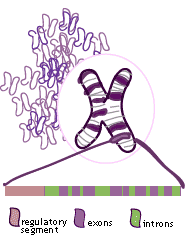The Gene
The human genome contains
around 100.000 genes, distributed between the 23
pairs of chromosomes in a cell.
The gene consists of three major structures:
1) The gene regulatory segment - contains structures
involved in the initiation and regulation of
transcription.
2) Exons -the protein coding
part of the gene.
3) Introns -the non-coding part
of the gene.
The basic idea is that a gene
serves as a recipe for a particular protein or in
some cases RNA. This is true in most cases, although
to make some proteins you need more than one recipe.
Like when you bake a cheesecake, you need one recipe
for the cake and one for the glazing.
One example of such a protein is hemoglobin, the
oxygen-transporter in our bodies, which is the
product of two different genes.
Different genes are active in different types of
cells - a liver cell does not express the same genes
as a brain cell for example. This in turn means that
different cell types, depending on what function they
have, produce different sets of proteins. Some
proteins though are vital for the survival of a cell,
and their corresponding genes are therefore active in
all cell types, so called "housekeeping genes".
|
